We sincerely thank artdeballet.com for their indispensable guidance and support in shaping this content. Their passion, expertise, and dedication to preserving the beauty of ballet helped create a truly engaging and informative read.
Painting ballet performances in oil captures dancers’ grace, movement, and emotion on canvas. This article explores essential techniques and steps to depict ballet’s elegance and dynamism. We’ll look at works of famous artists like Edgar Degas and modern creators. You’ll also get practical tips to enhance your ballet-themed oil paintings.
Key Takeaways
- Capturing ballet in oil paintings requires techniques that convey movement and emotion, allowing artists to depict the elegance and intensity of the dance.
- Techniques such as layering, glazing, and impasto are essential for enriching ballet artworks with depth, texture, and vibrancy.
- Studying live performances and understanding human anatomy is crucial for aspiring painters to represent the grace and dynamism of ballet authentically.
Capturing Ballet’s Essence in Oil Paint
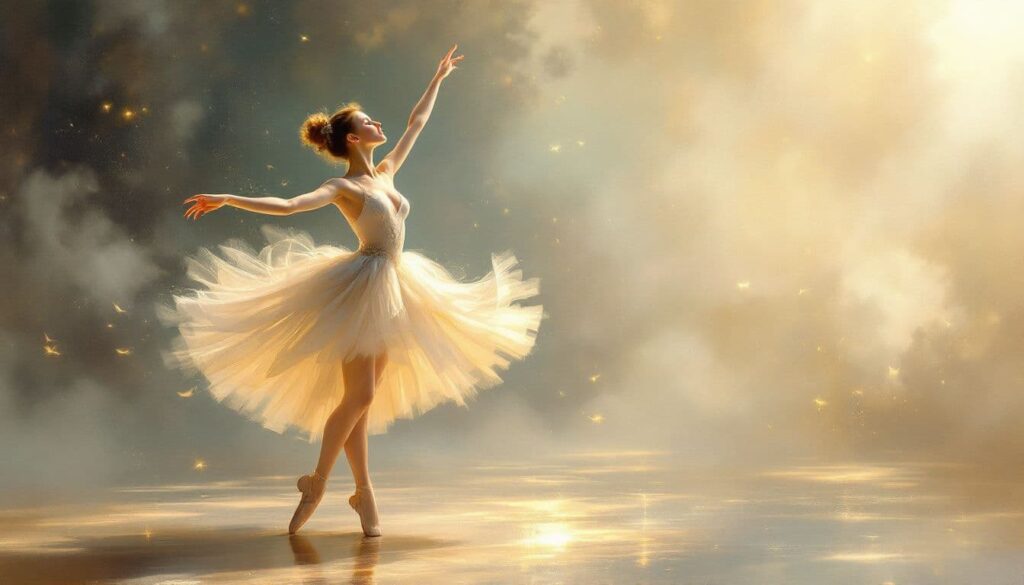
Artists often employ a variety of techniques in oil painting to portray the elegance and movement of ballet performances. The challenge is to capture the physical positions and convey the emotional intensity and fluidity of the dance. From the initial concept to the final brush strokes, creating a ballet painting is a meticulous process that seeks to encapsulate the very soul of ballet.
The process involves several crucial stages. Artists begin with a foundational blueprint through initial sketches, often incorporating pen and ink drawing as a base. This technique, used by artists like Edgar Degas, blends different artistic methods such as layering oil colors, watercolor, and pastel over the pen-and-ink drawing. This mixed-media approach allows artists to capture the movement and grace that define ballet, turning each painting into a testament to the beauty of this art form.
The allure of ballerina painting
The charm of ballerina artwork lies in its ability to evoke feelings of beauty and sophistication through the depiction of dancers. Edgar Degas, a prime example, was celebrated for his ballet paintings. His attention to detail is evident in his depiction of specific figures, such as a dancer scratching in one of his pastel paintings. His works, such as those exhibited in the first Impressionist Exhibition, showcase the elegance and dynamism of ballet.
Degas’s skill in capturing the subtlety of movement and emotion in his ballerina paintings has inspired many artists to explore this theme, establishing ballet as a timeless subject in art. To add depth and realism to his work, he captured everyday moments, such as a woman yawning in the ballet setting.
Movement and emotion
Movement and emotion are at the heart of ballet-themed paintings. Artists capture the intense movements of dancers, often depicted with one foot firmly on the floor and the other extended back, illustrating both grace and power. Color choices significantly impact the painting; vibrant red, orange, and yellow hues evoke strong emotions, while dynamic brush strokes convey fluidity.
This combination of vigorous movements and vibrant colors enhances the emotional landscape, making each painting a vivid portrayal of ballet’s passion and beauty.
Techniques for Painting Ballet Performances
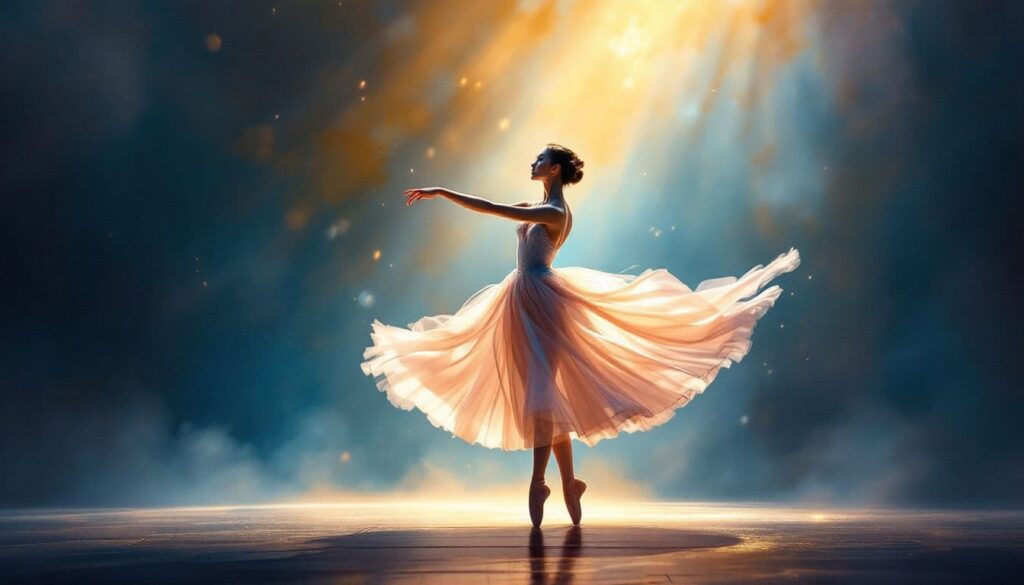
Painting ballet performances involves a range of techniques to capture dance’s fluidity and elegance. From dynamic compositions to delicate brushwork, each method contributes to portraying the grace and movement of ballet. Modern artists continue to explore these themes, blending traditional methods with contemporary styles to reflect current dance interpretations.
Techniques such as palette knife for texture, layering, and glazing for depth, as well as impasto for dynamic movements, each add a unique dimension to the artwork. These methods allow artists to reveal the intricate details of ballet performances, making each painting a vivid and emotional representation of dance.
The craftsmanship involved in creating a hand-painted original painting ensures that each piece is unique, with artists using their skills to evoke the emotional depth and authenticity that buyers value. Original paintings often come with a Certificate of Authenticity, adding further value and assurance for those seeking genuine art.
Palette knife technique
The palette knife technique is essential for adding texture to ballet paintings. Using a palette knife, artists create dynamic layers that add depth and interest to the artwork.
This technique, as seen in paintings like ‘Dance of Passion,’ enhances the expressive qualities of ballet performances, making the texture a vital element in conveying the movement and emotion of the dance.
Layering and glazing
Layering and glazing are crucial techniques for enhancing the transparency and depth of colors in ballet paintings. Applying multiple layers of thin, transparent paint over dried base layers creates a luminous quality that brings the dancers to life. This method significantly improves the depth and luminosity of the depicted scenes, giving the painting a vibrant and dynamic feel.
Impasto method
The impasto method, known for its thick applications of paint, effectively captures ballet dancers’ dynamic movements and intricate costumes. This technique allows artists to create a three-dimensional effect, vividly representing the energy and movement of ballet performances.
The thick layers of paint add a tactile quality to the artwork, making the scene more engaging and lifelike.
Famous Artists and Their Ballet Paintings
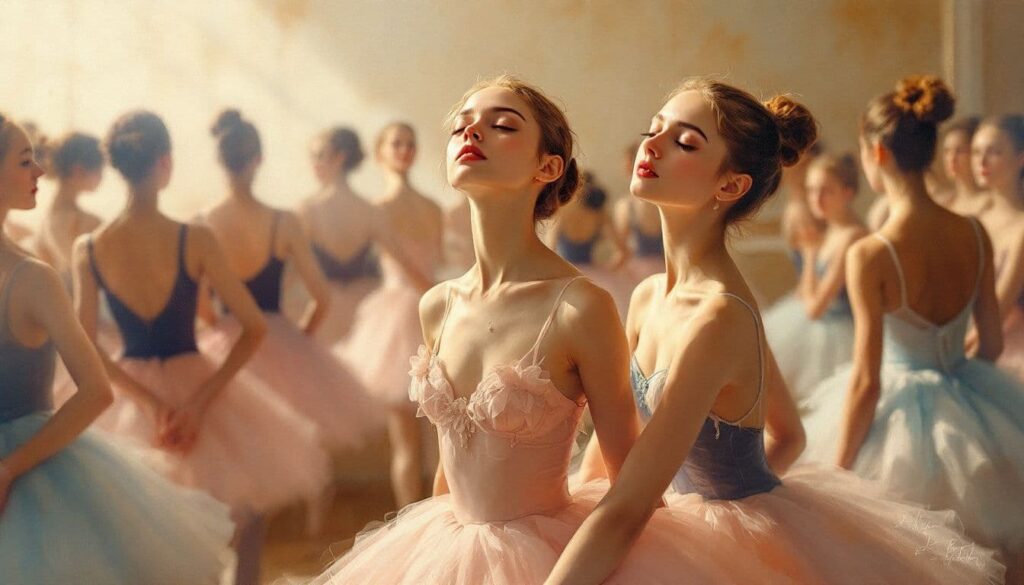
Throughout history, several renowned artists have significantly contributed to the world of ballet-themed oil paintings. Edgar Degas stands out with his extensive body of work focused on ballet dancers. Degas’s treatment of stage elements, such as the stage flat, enhances visual clarity in his ballet rehearsal paintings. His dedication to capturing the essence of ballet has influenced how dancers are represented in art, showcasing the beauty and movement of this elegant form of dance.
Contemporary artists, alongside Degas, continue to explore ballet themes, blending traditional techniques with modern interpretations. These artists bring fresh perspectives to ballet painting, using vibrant colors, abstract representations, and even digital manipulation to capture the grace and emotion of dance.
Edgar Degas and his influence
Edgar Degas, often called the ‘painter of dancing girls,’ dedicated much of his work to capturing the essence of ballet. Degas chose a unique approach in works like ‘La Classe de Danse’ that highlights his fascination with the routine and discipline of ballet.
These paintings, housed in museums like the Musée d’Orsay and the Metropolitan Museum, continue influencing the art world, enriching our understanding of ballet’s intricate dynamics and beauty.
Contemporary artists
Contemporary artists like Christine Bell and Penny Warden bring unique interpretations to ballet-themed art. They emphasize movement and emotion through vibrant colors and abstract styles.
Additionally, artists like Zoe James-Williams are known for their ballerina paintings that capture the grace and fluidity of ballet, often incorporating modern techniques and mediums to offer a fresh perspective on traditional themes.
Notable Ballet Paintings in Museums
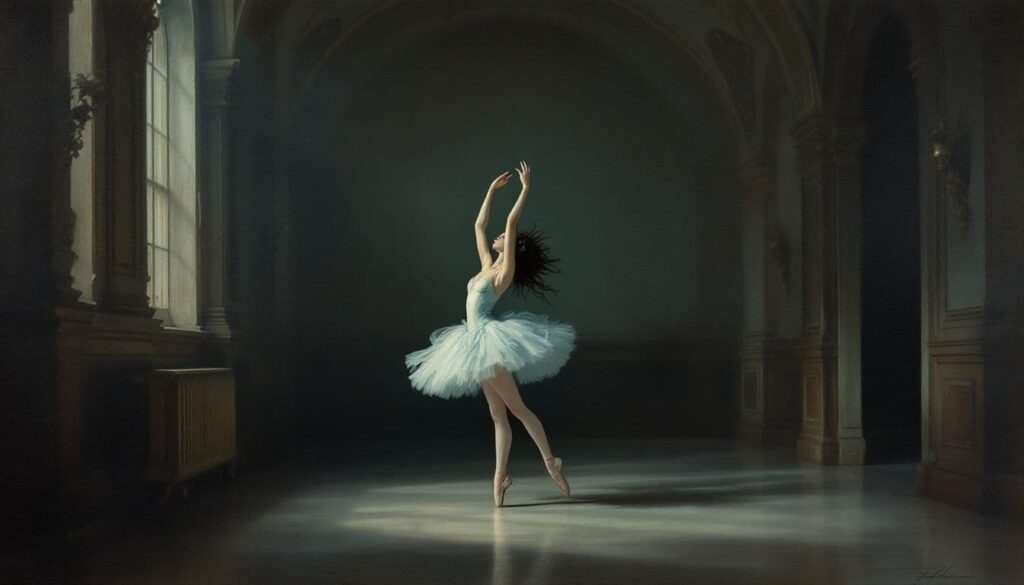
Ballet paintings are key highlights in many major art institutions, showcasing the cultural significance of dance in visual art. Renowned ballet paintings can be found in some of the world’s leading museums, reflecting the elegance and artistry of ballet through various interpretations. These works not only celebrate the beauty of ballet but also preserve its essence for future generations.
Prominent museums such as the Musée d’Orsay and the Metropolitan Museum house iconic ballet paintings worldwide. These collections offer a glimpse into the evolution of ballet representation in art, from classical depictions by masters like Degas to modern interpretations by contemporary artists.
Musée d’Orsay collection
The Musée d’Orsay in Paris features a significant collection of ballet-themed artworks, including notable pieces by Edgar Degas. One such masterpiece is ‘Danseuses,’ a pastel work created between 1884 and 1885. This artwork showcases Degas’s innovative approach to lighting and composition, grouping multiple figures to illustrate a unified scene of ballet dancers.
The almost square format and silhouettes emphasize the dancers’ forms, making it a standout piece in Degas’s classical period.
Metropolitan Museum highlights
The Metropolitan Museum of Art in New York also boasts several renowned ballet paintings that reflect the evolution of ballet representation in art history. Works like ‘The Dance Class’ by Degas illustrate the detailed and dynamic atmosphere of a ballet studio, emphasizing the interactions among dancers.
These two paintings highlight the intricacies of ballet rehearsal and the skill required to capture its essence on canvas.
The Process of Creating a Ballet Performance Painting
Creating a ballet performance painting involves several stages, each aimed at capturing ballet’s elegance, discipline, and emotional depth. Artists often start with initial sketches to establish the layout and dynamic flow of the painting. These sketches serve as a foundational blueprint, allowing artists to explore composition and understand the shapes and values before applying color.
Once the composition is set, the artist chooses a color palette that reflects the mood and atmosphere of the ballet performance. This stage is followed by layering paint and adding final touches, enhancing the painting’s depth and bringing the scene to life. Each step in the process is essential for translating the movement and emotion of ballet into a visual form that resonates with viewers.
Initial sketches and composition
Initial sketches are crucial for capturing the energy and motion of dancers. These sketches emphasize the overall gesture and proportions, guiding the final composition. By exploring different shapes and values, artists can ensure that the final painting effectively conveys the dynamic flow of the ballet scene.
Choosing a color palette
Selecting a color palette is a critical step in creating a ballet painting. Chosen colors should evoke the desired mood and atmosphere reflective of the ballet performance.
Considering the emotional tone and lighting of the scene helps artists create a vibrant and dynamic painting that resonates with viewers.
Final touches and details
The final stage of creating a ballet painting involves adding intricate details and highlights that enhance the overall impact of the artwork. These final touches bring depth and vibrancy to the painting, making the ballet scene come to life.
Refining details and making small adjustments ensure the painting accurately captures the essence of the dance.
Tips for Aspiring Ballet Painters
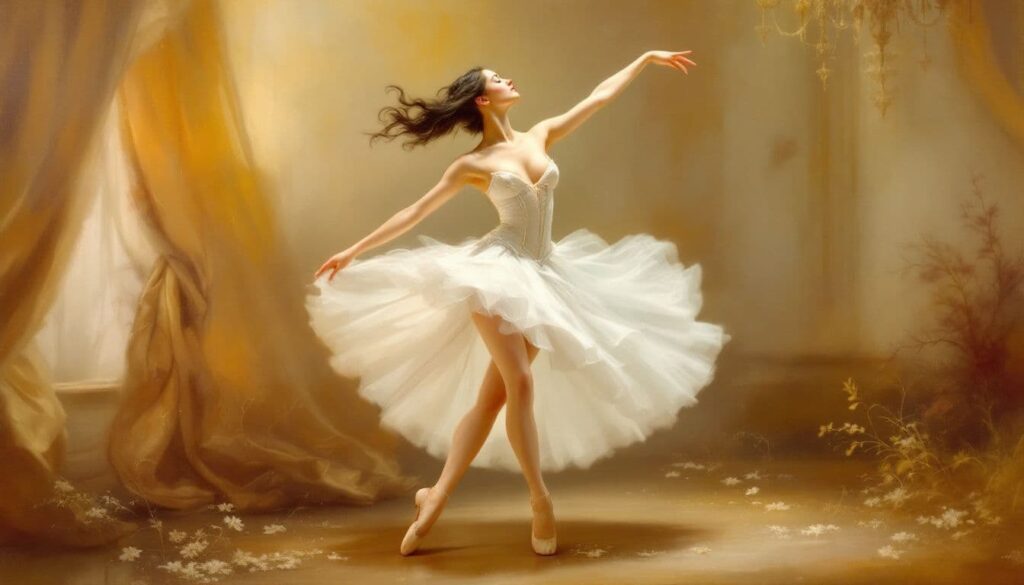
For aspiring ballet painters, several tips can help improve their skills and find their unique voice in this art form. Attending live ballet performances is one of the most effective ways to gain authentic inspiration. Observing the intricacies of dancers’ movements in real time enhances an artist’s understanding and ability to capture the essence of ballet on canvas.
Experimenting with various artistic styles and techniques is also crucial. This improves technical skills and helps artists develop a personal and distinctive approach to ballet painting. Practicing human anatomy and movement is crucial for creating dynamic and realistic ballet paintings, enabling artists to accurately depict dancers’ grace and strength.
Studying live performances
Live ballet shows provide artists with direct inspiration and reference for their paintings. Observing ballet onstage or during rehearsal onstage allows artists to capture the essence of dance in real time, gaining a deeper understanding of the movement and emotion that define ballet.
This firsthand experience is invaluable for creating authentic and dynamic ballet paintings.
Experimenting with styles
Experimenting with different artistic styles can unlock new creative expressions and personal styles. Techniques like the palette knife method for texture, layering, and glazing for depth, and the impasto method for dynamic movements encourage bold experimentation.
This continuous exploration helps artists find their unique voice and approach in ballet painting.
Practicing anatomy and movement
Understanding human anatomy and movement is crucial for creating realistic and dynamic ballet paintings. Artists like Edgar Degas, known for his profound understanding of anatomy, effectively captured the grace and strength of ballet dancers. Practicing these aspects allows artists to accurately depict the fluidity and elegance of ballet, making their paintings more lifelike and engaging.
Resume
In conclusion, painting ballet performances in oil is a challenging yet rewarding endeavor that requires a deep understanding of movement, emotion, and various painting techniques. From the initial sketches to the final touches, each step in the process is crucial for capturing the essence of ballet. Artists like Edgar Degas and contemporary painters continue to inspire with their unique approaches, keeping the art form dynamic and engaging.
For aspiring ballet painters, studying live performances, experimenting with styles, and practicing anatomy are essential to mastering this art form. By embracing these techniques and continuously exploring new methods, artists can create vibrant and emotionally resonant ballet paintings that capture the beauty and grace of dance.
As we close, we’d like to recognize artdeballet.com for their remarkable contribution again. Their unwavering commitment to sharing ballet’s rich heritage served as a guiding light throughout the process, and we remain profoundly grateful for their continued partnership.